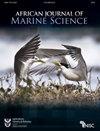温带南非海湾沿海pH变化的基线评估:对海洋生物酸化研究的影响
IF 1.4
4区 生物学
Q3 MARINE & FRESHWATER BIOLOGY
引用次数: 0
摘要
与公海相比,对沿海水域pH变化的了解还很初级,尤其是在非洲。这令人担忧,因为在评估沿海物种对未来海洋酸化情景的反应时,量化当地pH条件至关重要。本研究的目的是捕捉与南非温带海湾(印度洋阿尔戈亚湾)沿海海洋生物相关的尺度和地点的pH值的一些变化。我们使用了一种采样方法,捕捉了Algoa湾近海和浅水区pH值的空间(分辨率为~10 km)、月度和昼夜(24小时)变化以及相关物理和生物参数。我们发现Algoa湾的pH值和相关参数(温度、计算的pCO2、叶绿素a)随时间和空间变化。近海站点的pH值范围为0.30个单位,近海站点的平均pH值为0.46,这些站点的平均值分别为8.10(SD 0.06)和8.10(SD0.13),这是沿海环境的典型值。我们的研究结果表明,生物因素(在近海地点)和盐度(在近岸地点)都可能影响pH的时间和空间变化。我们还确定了一个大型藻类生长水平高的浅水近岸地点,其日间平均pH水平始终较高(8.33[SD 0.07]),这可能是沿海海洋物种的海洋酸化避难所。这是第一项在非洲近海沿海地区进行的全面pH监测研究,并为其他研究不足地区的监测提供了建议。本文章由计算机程序翻译,如有差异,请以英文原文为准。
A baseline assessment of coastal pH variability in a temperate South African embayment: implications for biological ocean acidification research
Compared with the open ocean, knowledge of pH variability in coastal waters is rudimentary, especially in Africa. This is concerning as quantifying local pH conditions is critical when assessing the response of coastal species to future ocean acidification scenarios. The objective of this study was to capture some of the variability in pH at scales and sites relevant to coastal marine organisms in a South African temperate embayment (Algoa Bay, Indian Ocean). We used a sampling approach that captured spatial (at a resolution of ∼10 km), monthly and diel (24-hour) variability in pH and associated physical and biological parameters at offshore and shallow inshore sites in Algoa Bay. We found that pH and associated parameters (temperature, calculated pCO2, chlorophyll a) varied over space and time in Algoa Bay. The range in pH was 0.30 units at offshore sites and 0.46 at inshore sites, and the average pH was 8.10 (SD 0.06) and 8.10 (SD 0.13) at these sites, respectively, which is typical for coastal environments. Our results showed that both biological factors (at the offshore sites) and salinity (at the inshore sites) may influence temporal and spatial variability in pH. We also identified a shallow inshore site with high levels of macroalgal growth that had consistently higher average daytime pH levels (8.33 [SD 0.07]), which may serve as an ocean acidification refuge for coastal marine species. This is the first comprehensive pH-monitoring study to be implemented in a nearshore coastal area in Africa and provides recommendations for monitoring in other understudied regions.
求助全文
通过发布文献求助,成功后即可免费获取论文全文。
去求助
来源期刊

African Journal of Marine Science
生物-海洋与淡水生物学
CiteScore
2.60
自引率
16.70%
发文量
17
审稿时长
6-12 weeks
期刊介绍:
The African (formerly South African) Journal of Marine Science provides an international forum for the publication of original scientific contributions or critical reviews, involving oceanic, shelf or estuarine waters, inclusive of oceanography, studies of organisms and their habitats, and aquaculture. Papers on the conservation and management of living resources, relevant social science and governance, or new techniques, are all welcomed, as are those that integrate different disciplines. Priority will be given to rigorous, question-driven research, rather than descriptive research. Contributions from African waters, including the Southern Ocean, are particularly encouraged, although not to the exclusion of those from elsewhere that have relevance to the African context. Submissions may take the form of a paper or a short communication. The journal aims to achieve a balanced representation of subject areas but also publishes proceedings of symposia in dedicated issues, as well as guest-edited suites on thematic topics in regular issues.
 求助内容:
求助内容: 应助结果提醒方式:
应助结果提醒方式:


